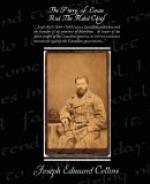long, five or six feet in width, and only three or
four feet high.” The objective point of
Major-General Middleton’s march was Batoche’s
Crossing, where Riel had several large pits sunk,
and fortifications thrown up, for a grand and final
encounter with our troops. The line of march
lay sometimes along the Saskatchewan’s banks,
but more frequently through the open prairie.
The position of the rebels prior to the battle was
this: Dumont, with 250 half-breeds and Indians,
had been retreating slowly before General Middleton’s
right column on the east bank of the river, their
scouts keeping them informed of the General’s
movements. Dumont appears to have thought of
waiting for the troops to attack him on Thursday night;
at least that is the belief of the scouts, who saw
some of his mounted men signalling to him all afternoon
on Thursday. However that may be, he lay waiting
for our men at the edge of a big
coulee near
Fish Creek, early on Friday morning, his forces being
snugly stowed away behind boulders, or concealed in
the dense everglades of hazel, birch, and poplar.
From day to day, almost from hour to hour, this veteran
buffalo hunter had learned every tidings of the General’s
troops that keen observation made from clumps of bush
along the prairie could give him. So when he
learnt that the General himself, with his officers,
were near at hand, his eyes fairly gleamed with enthusiasm.
“My men,” he said, as he went from covert
to covert, from bluff to bluff, “you know the
work that lies before you; I need not repeat it to
you. Do not expose yourself, and do not fire
unless you have a tolerable target.” Then
he arranged a system of signals, chiefly low whistles
and calls, by which the men would be able to know
when to advance, retire, lie close, make a dash, or
move from one part of the ground to another.
“They will at first fall into an ambush,”
he said, “then, my men, be nimble. In the
panic there will be a rich harvest for you. Bring
down the General if you can. Wherever an officer
is in range, let him have a taste of your lead in
preference to the privates.” Then he lay
close and watched, and listened, many times putting
his ear to the ground. At last he gave an exclamation.
It was in a whisper; but the silent rebels who lay
there, mute as the husht trees around them, could
well hear the words, “they come!”
Let me now briefly describe the position which the
rebel had chosen for himself. About five miles
from McIntosh’s stand two bluffs, about five
hundred yards apart, thickly wooded on the top.
Between these bluffs is a level open prairie that
extends backward about a thousand yards, across which
there runs a deep ravine, thickly timbered at the
bottom.




